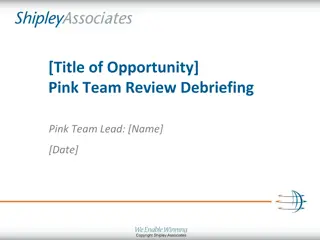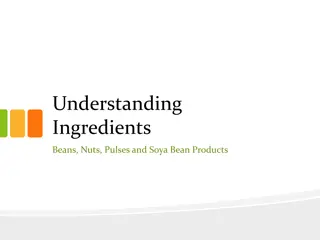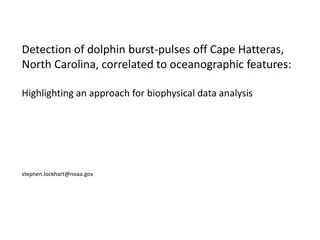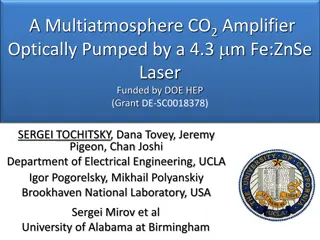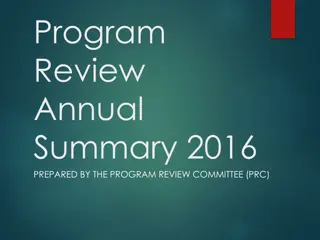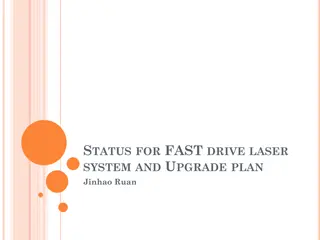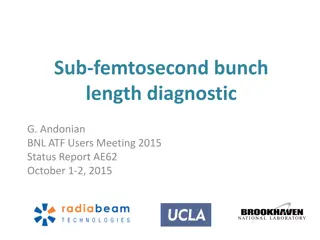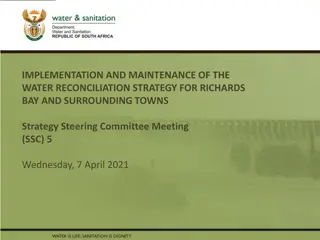Review Meeting on CFLDs on Pulses under NFSM - Summary and Action Plan
A review meeting on CFLDs on pulses under NFSM was organized in 2019-20, with an action plan for 2020-21 presented by Dr. S.K. Singh & Dr. M. S. Meena from ICAR-ATARI, Jodhpur. Major initiatives by KVKs include targeted technological packages, farmer involvement, and participatory planning. The targets and achievements of CFLDs on pulses in 2019-20 were also outlined, showcasing significant contributions in various pulse crops. Yield gap analysis between CFLDs, farmer practices, state, and national average yields for 2019-20 further highlighted areas for improvement. The action plan for CFLDs on pulses for 2020-21 focuses on specific crops in Rajasthan, Haryana, and Delhi, with targeted areas and CFLD numbers listed.
Download Presentation

Please find below an Image/Link to download the presentation.
The content on the website is provided AS IS for your information and personal use only. It may not be sold, licensed, or shared on other websites without obtaining consent from the author. Download presentation by click this link. If you encounter any issues during the download, it is possible that the publisher has removed the file from their server.
E N D
Presentation Transcript
Review Meeting on CFLDs on Pulses under NFSM organized during 2019-20 and Action Plan for 2020-21 Dr S.K. Singh & Dr. M. S. Meena ICAR-Agricultural Technology Application Research Institute, Zone-II, Jodhpur (Rajasthan) www.atarijodhpur.res.in Presented during Review Workshop on NFSM-Pulses on 10th June 2020 through video-conferencing.
Major Initiatives/issues undertaken by KVKs i. Situation specific Technological packages are decided based on gap analysis between existing & recommended practices in each season. Critical inputs are decided/rationalized as per financial norm in each crop. Critical practices are also demonstrated as per demand and applicability under different Farming Situations. Participatory planning, execution, monitoring and evaluation is done. Farmer s contribution is also taken especially in chickpea demonstration as seed rate (kg/ha) is more in chickpea in comparison to other pulse crops, 20-25 percent cost of seed is borne by farmer s themselves. Involvement of subject matter specialists of Agronomy, Plant Protection, Agriculture Extension and Home Scientist in finalization of technological packages, execution, monitoring & evaluation of CFLDs. Majority of KVKs of Rajasthan have initiated to mobilize farmers to keep as seed of produce under Front Line Demonstration for next year Farmer-Farmer diffusion and large scale multiplication. ii. iii. iv. v. vi.
Targets & Achievements of CFLDs on Pulses 2019-20 Sl. No. ` Area (ha) No. of CFLDs Targets Achievements Crop Area (ha) No. of CFLDs 1 Black gram 250.00 625 260.00 650 Green gram (Kharif) 2 570.00 1425 550.00 1375 3 Moth bean 220.00 550 177.16 443 4 Pigeon pea 60.00 150 65.00 163 5 Chickpea 1040.00 2600 1122.00 2805 6 Lentil 60.00 150 46.00 115 Green gram (Summer) 7 500.00 1250 500.00 1250 Total 2700.00 6750 2720.16 6801
Yield gaps between CFLDs, farmer practice, state, national average yields (2019-20) Yield gap between CFLDs yield & National avg. yield (q/ha) Yield gap between CFLDs yield & Farmers practice (q/ha) Yield gap between CFLDs yield & State avg. yield (q/ha) Farmers practise (q/ha) State average yield (q/ha) National average yield (q/ha) Name of State CFLDs yield (q/ha) Name of Crop (1) (2) (3) (4) (5) (6)=(3-4) (7)=(3-5) Green gram- Kharif Rajasthan 7.61 5.86 5.54 - 1.75 2.07 - Green gram- Kharif Haryana 8.11 4.30 5.18 - 3.81 2.93 - Rajasthan Moth bean 5.03 3.92 3.06 - 1.11 1.97 - Rajasthan Black gram* 4.37 4.26 2.54 - 0.11 1.83 - Rajasthan Chickpea 19.31 15.11 12.56 10.63 4.20 6.75 8.68 Haryana Chickpea 13.51 11.06 8.45 10.63 2.45 5.06 2.88 * Low yield in Black gram crop due to the heavy rainfall in Kota region during Kharif-2019.
Action Plan for CFLDS-Pulses for 2020-21 Sl. NO. Name of Crop Rajasthan Haryana Delhi Total Area (ha) No. of CFLDs Area (ha) No. of CFLDs Area (ha) No. of CFLDs No. of CFLDs Area (ha) 1 Black gram 290.00 725 - - - - 270.00 675 2 Moth bean 220.00 550 - - - - 220.00 550 Green gram (Kharif) 3 500.00 1250 50.00 125 - - 570.00 1425 4 Pigeon pea 60.00 150 20.00 50 - - 80.00 200 5 Chickpea 910.00 2275 140.00 350 20.00 50 1070.00 2675 6 Lentil 20.00 50 40.00 100 - - 60.00 150 Green gram (Summer) 7 70.00 175 410.00 1025 20.00 50 500.00 1250 Total 2070.00 5175 660.00 1650 40.00 100 2770.00 6925 Implementing KVKs: Rajasthan; 44 Haryana = 18; Delhi=1 Total: 63
Technology to be demonstrated under CFLDs on Pulses-2020-21 Based on the gap assessment in existing & recommended practices Crop Varieties Seed treatment Weed Management Fertilizer Management Insect pest and Disease Kharif-2020 Green gram Pre emergence (PE): Pendimethalin @ 1.0-1.5 a.i./ha, in 500-800 lit. of water. Post emergence: Imazethapyr a.i. 10 SL@3.30 litre/ ha in 500-600 litre of water at 20-25 DAS IPM-02-03, IPM-205-7, Shika, 421, GAM-5 Irrigated: N: P: K: S 20:40:20:20 Termite- Chlorpyriphos 400ml/100 kg seed, Fipronil 5 SC 10.0 ml. Seed treatment with fungicide. Seed inoculation with Rizobium & PSB culture. Management of sucking pests (Jasid whitefly at flowering stage) MH- Black gram Pre emergence (PE): Pendimethalin @ 1.0- 1.5 a.i./ha in 500-600 litre of water. Post emergence: Imazethapyr a.i. 10 SL@ 3.30 litre/ ha in 500-600 litre of water at 20-25 DAS Carbendazim + Thiram (1+2 gm/kg seed); for seed born disease. or Trichoderma spp. seed) and Rhizobium spp. .(one packet (200 g) for /10 kg seed), PSB cultures each @ 15-20 g/Kg seed for utilizing atmospheric N. (one packet (200 g) of culture for /10 kg seed) Termite- Chlorpyriphos 400ml/100 kg seed, Fipronil 5 SC 10.0 ml. Irrigated: N: P: K: S 20:40:20:20 PU-31, Pratap Urd-1, Urd-40, Azad Urd-3 Management of sucking pests (Jasid whitefly at flowering stage) Pant Pigeonpea Pre emergence (PE): Pendimethalin @ 1.0-1.5 a.i./ha in 500-600 litre of water. Post emergence: Imazethapyr a.i. 10 SL@ 3.30 litre/ ha in 500-600 litre of water at 20-25 DAS Thiram 80 WP @ 2.0-3.0 g/kg seed or Trichoderma Spp. (one packet (200 g) for 10 kg seed) and rhizobium spp., PSB Irrigated: N: P: K: S 20:60:20:20 Management of Leaf-roller PUSA-992 (Early Pigeonpea) Management of Pod-borer Pre-emergence (PE): Pendimethalin @ 1.0- 1.5 a.i. /ha Post emergence: Imazethapyr SL@3.30 litre/ ha in 500-600 litre of water at 20-25 DAS Rabi-2020-21 Alachlor or Fluchloralin @1.5 a.i./ ha (Pre showing), Pendimethalin @ 1 kg a.i./ha (pre- emergence) Imazethapyr (a.i.) 10 SL @ 40- 75gm/ha Moth bean Termite- Chlorpyriphos 400ml/100 kg seed, Fipronil 5 SC 10.0 ml Seed treatment with fungicide. Seed inoculation with Rizobium & PSB culture. Irrigated: N: P: K: S 20:40:20:20 Need based management of Insect Pest and diseases RMO-252 a.i. 10 Chickpea Root rot & Wilt- Thiram 3.0, Carbendazim 1.0-2.0, Carbendazim 1.0 + Thiram 2.0 g, Trichoderma viridae/T. harzenium 8.0-10.0 gm/kg seed Termite- Chlorpyriphos 400ml/100 kg seed, Fipronil 5 SC 10.0 ml. Seed treatment with fungicide. Seed inoculation with Rizobium & PSB culture. Irrigated: N: P: K: S 20:40:20:20 Unirrigated: N: P: K: S 20: 40:20:20 GNG-1958, GNG-2171, GNG-2144, HC-5 Management of wilt and dry root rot Management of Pod-borer Lentil IPL-316 Pratap Masoor-1 Foliar spray of Zincsulphate Management of wilt Management of Aphids * Cost of Chemical fertilizers has been invested by farmers themselves.
Budget Utilized during 2019-20 O.B. as on 1.4.2019 Fund received during 20219-20 Total fund available during 2019-20 Expenditure during 2019- 20 C.B. as on 31.3.2020 95.78 lakh 1.32 crore 2.27 crore 1.74 crore 53.22 lakh






